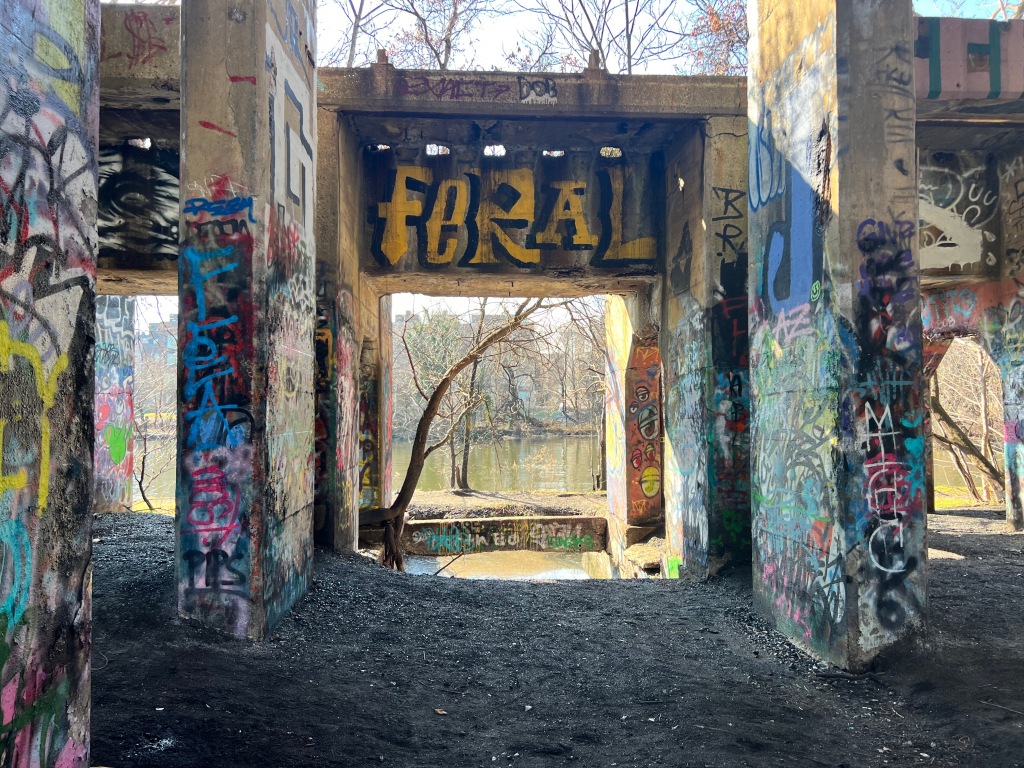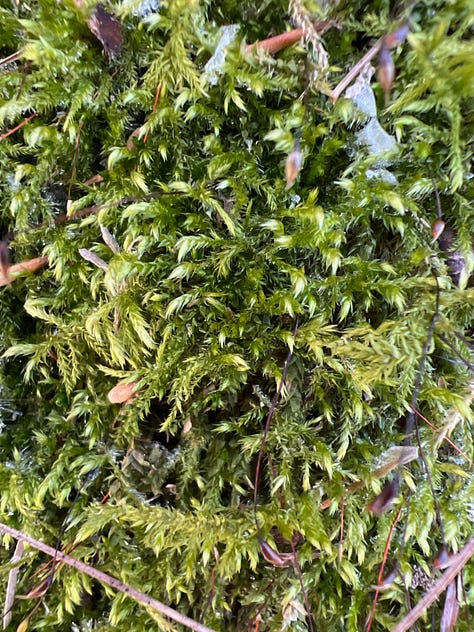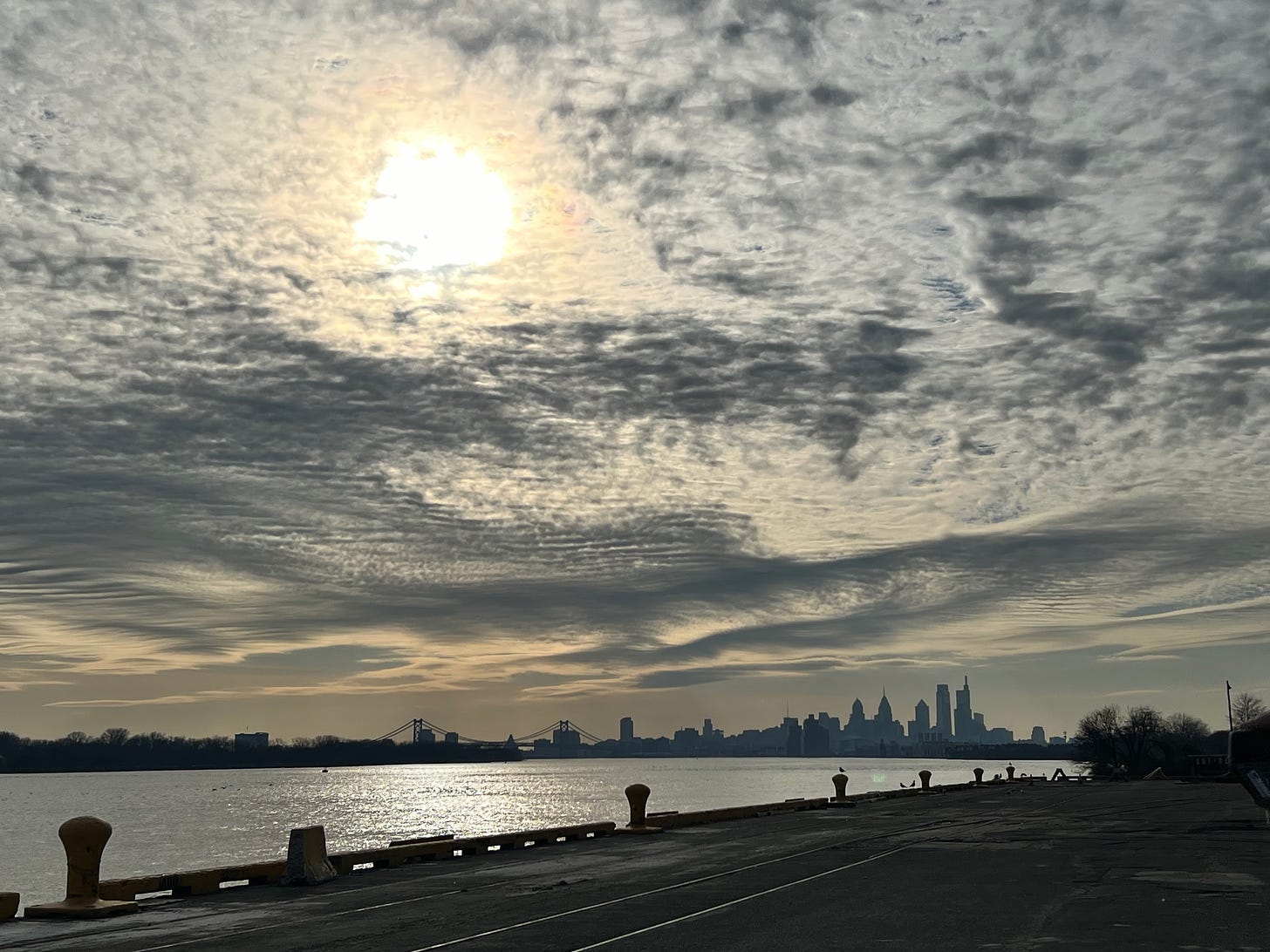Graffiti Pier, Philadelphia, Pennsylvania

Several people have asked how No Trespassing, this book I’m writing, is coming along. It is, it’s coming along, I promise! Many months later than I’d planned, but given that I have a job (for those who don’t know, I work as a copy editor for K-12 textbook publishers) and am the primary caregiver in my household, I should have planned more flexibly. I thought tinkering out this first chapter on land ownership would be straightforward, since it’s what I’ve researched most, but that might be part of the problem. It keeps sprawling, with always another book to read, on top dealing with of a number of personal situations over the last couple months. You know, weeks of scrambling around some half-emergency but also doesn’t everyone want to know just a little more about how much John Locke tailored his philosophy to justify colonial land theft?
I can research forever, it’s a problem.
I’m finally feeling like it’s taken form enough to get back in touch with my generous beta readers about their timelines and availability. The second chapter, on water, was written for my original book proposal, so it should take far less time to get in shape (famous last words). Thank you for your patience and interest in this work! I think it’s important, and I’m grateful that you do, too.
A couple of weeks ago I met someone I’ve revered for years: Lucy, named Dink’inesh in Amharic, meaning “you are marvelous.” Dink’inesh is of the species Australopithecus afarensis, one of Homo sapiens’ many hominin ancestors, and lived approximately 3.2 million years ago. Paleoanthropologist Jerry DeSilva, whom I interviewed about bipedalism for A Walking Life and who invited me to Dartmouth College to talk with students recently, showed me around his lab and there she was—a replica; Lucy herself is safely in Ethiopia, her home—resting on a foam bed sculpted to fit her bones.
It’s hard to describe how thrilling this kind of meeting is for me. I wrote about the feeling in A Walking Life, when Nick Ashton at the British Museum handed me a cast of fossilized footprints found on the Norfolk coast and estimated to be between 800,000 and 900,000 years old; it’s the depth of time that gets me, that immense geological knowing of planetary life.
Thrill is the best word I can think of to describe these encounters. A shiver down the spine, the sense of being in the presence of wonder and mystery, life that puts every one of my own existential worries into the context of time so vast that it’s a miracle we’re even aware of our own existence.
On that same trip, I got to meet up and walk with several people whose conversation and company put those same existential worries into a different kind of context, the one brought by reminders of our interconnections and relationships. The contexts that make human life beautiful and worthwhile for me and remind me what I learned while researching A Walking Life: most people want the best for others. Sometimes it can feel like that “most” barely scrapes 50% of humanity, but it’s there nevertheless. I’ve learned it over and over, probably because I’ve had to learn it over and over. It’s too easy for me to believe the opposite.
I got to meet, in person for the first time ever, two women I’ve been in a writing group with for well over a decade. We were meeting over Google Hangouts once a month long before online gatherings became the norm! To be able to hug them both, walk through Mount Auburn cemetery in Cambridge, Massachusetts, while we talked, and share food and more hugs, meant more to me than I realized it would. These people have been special to me through half of my writing life and almost my entire parenting life, and I’m grateful, even, for all the hard times we’ve shared together.
Before I met with Jerry DeSilva and his students, field biologist Bryan Pfeiffer, who writes the excellent nature-focused newsletter Chasing Nature, went farther out of his way than he should have so that we could go for a walk together on part of the Appalachian Trail and into an ice-covered hemlock forest, looking for mosses and lichens and talking about writing, books, the trials and tribulations of digital media platforms, and what I could use to take better pictures of Moon if I give up my smartphone (something I’m thinking about). I’ve learned so much about birds, dragonflies, buds, and photography from Bryan’s writing, it’d be hard to describe it all, but it doesn’t come close to hanging out in person for a few hours.

From there I had a fly-through visit with an old friend from graduate school, and then took a bus and then a train to Philadelphia, where JJ Tiziou let me stay at his place so I could participate in his Walk Around Philadelphia, which is in its third year. I was really looking forward to this walk because I love that kind of thing but even more so because writers Thomas Pluck and Chad O live in the region and had told me they signed up for it.
I wrote a whole book about walking, I might have mentioned a few times, and I wholeheartedly believe in its gifts for us as individuals, for our communities, for nature and our sense of belonging in this world. But I feel like I’m always relearning those same lessons. I was looking forward to talking with Chad about his
Scientific Animism work, and meeting Tom and telling him how much I enjoyed his posts about the New Jersey Pine Barrens, and his thriller The Boy from County Hell, which I’d read on the plane (as I said to him, I don’t usually read thrillers because I don’t handle violence well, but I fell for the characters immediately and it made a welcome break from forcing myself through chapters of Ellen Meiksins Wood’s The Origin of Capitalism), and when we were all gathered at the meeting spot I met reader Caroline (hi!), who’d come up from Washington, D.C., and whose work in Kazakhstan I still want to know more about.
It was in walking with these people and having these conversations that I remembered all the things I believe about walking, that it connects us to one another and to ourselves, that it reminds us that we’re animals evolved on a living planet, that it makes our interactions richer, that it brings us face to face with a world that our species has been co-evolving with even before Lucy and her people lived what I’m certain were loving, fraught, rich lives on the land that is now called Ethiopia.
Tom has a great post on his newsletter about this walk, which has more and better photos—including a selfie of the two of us—and Chad found me an almost completely faded “No Trespassing” sign that I’d overlooked while wondering if I should crawl through a hole in the fencing.
When A Walking Life was being published, I told the marketing people that I’d wanted to write a book for the “everywalker.” I was tired of reading about philosophers and writers wandering through pristine woods and up remote mountain peaks. This is our world, I’ve said. We have the right to walk it, in all its glory and grit.

Being reminded of these realities matters to me. These connections and relationships matter to me. All of it: walking with old friends I’d never met in person, walking with a friend and colleague in a gorgeous frozen forest, walking with new friends and acquaintances along the sometimes ragged-looking borders of a city beloved (hopefully) by a million and a half people.
I carried Lucy with me that day, walking the border of Philadelphia. In his descriptions of the walk, JJ asks participants to consider borders and boundaries, including within ourselves. Where are our own mental and physical limitations? How do we negotiate decisions, like which half-formed path to take in a woods unknown to any of us, or when to stop at the end of the day?
After miles of walking through woods and on concrete, my left knee let me know how much it disapproved of all this motion. The group tried unsuccessfully to find a place for a cold drink and possibly hot food; Tom and I lingered back, talking and, in my case, wondering when I could give my knee a rest.
When paleoanthropologist Donald Johanson first found Lucy in 1974, he found her left knee crushed beyond repair, destroying a key piece of evidence about her bipedalism.* But her spine, pelvis, and foot bones, along with other evidence from nearby fossils of her species, confirm that she walked upright on two legs. If I remember correctly what Jerry DeSilva has told me, signs in her vertebra also point to the possibility that she lived with pain.
Lucy tells us a tremendous amount about how we came to be what we are. One of the reasons I find the presence of her kind of deep time so thrilling is that these details of evolution tell us just as much about who we are, if we let them. Lucy likely experienced pain, just like I did walking miles around Philadelphia. Did she ever ask her group to slow down, take a break, as I perhaps should have?
Walking with a group, especially when I’m tired or hungry or need a bathroom or am in pain, reminds me of something else I learned when researching walking: the hominin fossil record has many examples of people with various disabilities, whether from injury or birth, being valued and fully equal members of their communities. The weight of scientific evidence points to the reality that we evolved to be interdependent, and to care for one another—a reality innate to our development, not an offshoot of it. The more recent proposition that humans evolved to be individualistic and competitive is contradicted by millions of years of hominin history.
I was more than happy to come back home, catch up on sleep (and a backlog of laundry, homework, and decaying food in the fridge), go for a walk with a couple of close friends and another longer walk by myself, and coddle my aggrieved knee. But getting out and meeting people, slowing down and walking with them instead of corresponding over texts and emails, brought me back to what this is all about, the writing, the walking, the living, the multi-dimensional relating, the negotiating of physical and emotional needs: it’s about one another, and how we manage to live, and walk, together.
We exist. It’s a miracle. Time is vast, our lives are brief. Remember: you are marvelous.
*There is a particular angle the knee develops in upright walking, called a bicondylar angle, a tilt in the femur caused by downward pressure as babies start to walk. Jerry DeSilva wrote about these details, and his work with Lucy and many other hominin fossils, in his excellent book First Steps: How Upright Walking Made Us Human.
This sky! Philly, you beauty.
